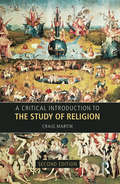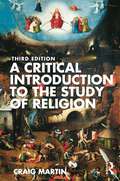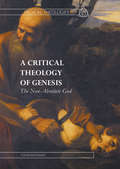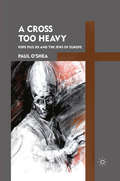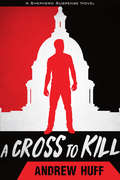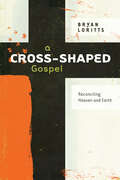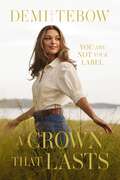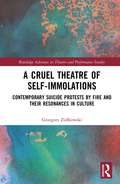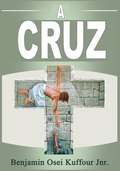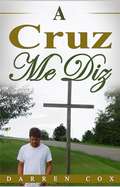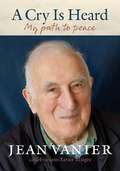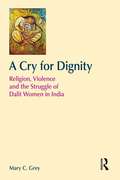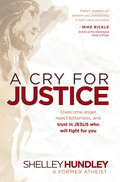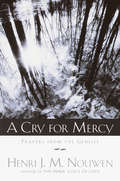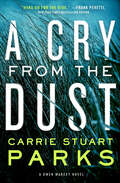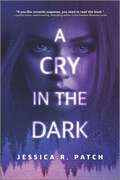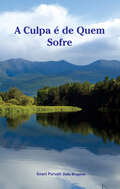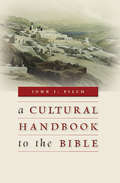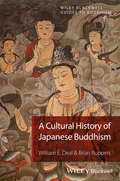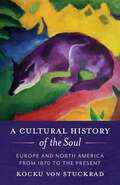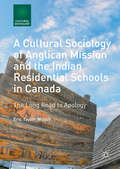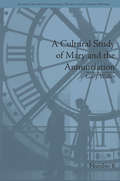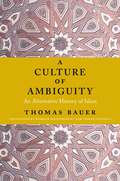- Table View
- List View
A Critical Introduction to the Study of Religion
by Craig Martin'A Critical Introduction to the Study of Religion' explains the key ideas and methods in the study of religion and demonstrates how they can be used. The aim is to provide students with a tool-kit of critical concepts for studying religious belief and behaviour. Throughout the discussion all ideas and methods are illustrated with clear case material.
A Critical Introduction to the Study of Religion
by Craig MartinA Critical Introduction to the Study of Religion introduces the key concepts and theories from religious studies that are necessary for a full understanding of the complex ways in which religious and cultural institutions and traditions influence society. This book provides readers with an arsenal of critical concepts for studying religious ideologies, practices, and communities. This edition has been thoroughly revised and now includes a new chapter on "Belief" and a rewritten chapter on "Essentialism," and has been restructured to clearly emphasize key topics including: problems with the concepts of "religion" and "belief systems;" functionalism and classification; essentialism, socialization, and habitus; and legitimation, authority, and authenticity. All ideas and theories are clearly illustrated, with contemporary and engaging examples and case studies throughout. It’s an essential text for all students approaching the subject area for the first time.
A Critical Inventory of Ramayana Studies in the World, Volume II: Foreign Languages
by K. KrishnamoorthyThe second volume of the Inventory lists Ramayana Studies in foreign languages.
A Critical Theology of Genesis: The Non-Absolute God (Radical Theologies and Philosophies)
by Itzhak BenyaminiIn this book Itzhak Benyamini presents an alternative reading of Genesis, a close textual analysis from the story of creation to the binding of Isaac. This reading offers the possibility of a soft relation to God, not one characterized by fear and awe. The volume presents Don-Abraham-Quixote not as a perpetual knight of faith but as a cunning believer in the face of God's demands of him. Benyamini reads Genesis without making concessions to God, asking about Him before He examines the heart of Adam, Noah, Abraham, and the other knights of faith (if they are really that). In this way, the commentary on Genesis becomes a platform for a new type of critical theology. Through this unconventional rereading of the familiar biblical text, the book attempts to extract a different ethic, one that challenges the Kierkegaardian demand of blind faith in an all-knowing moral God and offers in its stead an alternative, everyday ethic. The ethic that Benyamini uncovers is characterized by family continuity and tradition intended to ensure that very axis--familial permanence and resilience in the face of the demanding and capricious law of God and the everyday hardships of life.
A Cross Too Heavy: Pope Pius XII and the Jews of Europe
by Paul O'SheaThe papacy of Pius XII (1939-1958) has been a source of near-constant criticism and debate since his death, particularly because of his alleged silence during the Holocaust. Paul O'Shea examines his little-studied pre-papal life to demonstrate that Pius was neither an anti-Semitic villain nor a 'lamb without stain. '
A Cross to Kill (A Shepherd Suspense Novel #1)
by Andrew HuffA gripping debut thriller pits a man of God against terrorists--and his own deadly pastJohn Cross is a small-town pastor, bent on leading his flock to follow God's calling. He's not the sort of man one would expect to have a checkered past.But the truth is that the man behind the pulpit preaching to his sheep was once a wolf--an assassin for the CIA. When John decided to follow Christ, he put that work behind him, determined to do penance for all the lives he took. He vowed never to kill again.Now someone wants the peaceful pastor to pay for his sins with his own life. And when a terrorist out for revenge walks into the church, John's secrets are laid bare. Confronted with his past, he must face his demons and discover whether a man can truly change. Can he keep his vow--even when the people he loves are in mortal danger? Will his congregation and the brave woman he's learning to care for be caught in the cross fire? In the end, John's life may be the only sacrifice he has left to offer. . . Andrew Huff's thrilling debut is not only a riveting story of suspense, it's also a deep exploration of the moral quandaries that face those who choose to follow the Prince of Peace in a violent world.
A Cross-Shaped Gospel: Reconciling Heaven and Earth
by Bryan LorittsWARNING! This book could make your life messy!Today&’s church is continually being confronted with the question, &“What is the gospel?&” Many churches answer this through strong exposition of biblical truth. Others answer with a focus on community engagement. But doesn&’t Christ call us to do both? The covenant of salvation demands a radical re-patterning of relationships. Bryan Lorrits, a pastor in the heart of one of America&’s historically racially divided urban centers, seizes the opportunity to engage God, the church, and culture in ways that may challenge your beliefs, practices, and relationships.A Cross-Shaped Gospel clearly articulates the vertical dimension of the Christian faith, as well as looking at the horizontal implications of salvation for growth, service, and community. It provokes readers to think about the implications of living out their faith. What does the gospel mean for issues of:Political engagement?Class distinctions?Race Relations?It is only by reaching upward that we can reach outward in power and with the proper motives, so let A Cross- Shaped Gospel help you in crafting and communicating a biblical philosophy of engaging God and others well!
A Cross-Shaped Gospel: Reconciling Heaven and Earth
by Bryan LorittsWARNING! This book could make your life messy!Today&’s church is continually being confronted with the question, &“What is the gospel?&” Many churches answer this through strong exposition of biblical truth. Others answer with a focus on community engagement. But doesn&’t Christ call us to do both? The covenant of salvation demands a radical re-patterning of relationships. Bryan Lorrits, a pastor in the heart of one of America&’s historically racially divided urban centers, seizes the opportunity to engage God, the church, and culture in ways that may challenge your beliefs, practices, and relationships.A Cross-Shaped Gospel clearly articulates the vertical dimension of the Christian faith, as well as looking at the horizontal implications of salvation for growth, service, and community. It provokes readers to think about the implications of living out their faith. What does the gospel mean for issues of:Political engagement?Class distinctions?Race Relations?It is only by reaching upward that we can reach outward in power and with the proper motives, so let A Cross- Shaped Gospel help you in crafting and communicating a biblical philosophy of engaging God and others well!
A Crown that Lasts: You Are Not Your Label
by Demi-Leigh TebowIn A Crown that Lasts, former Miss Universe and Miss South Africa Demi Tebow confesses the danger of tying our identities to our accomplishments. Discover the truth of who you were created to be and how to use your platform, no matter how big or small, for eternal impact.On this earth, a crown is what separates victors from the rest of the competitors, but the goal of creating a life worth living is not to gain a trophy, get a prize, or keep the crown. Our lives are not meant to be about being number one or making our own names known. While walking you through the journey of her evolving confidence—from basing her identity on temporary labels and her own efforts, to discovering the rock-solid security of anchoring her dreams in her Maker—Demi weaves her story together with the insights she's learned along the way.A Crown that Lasts will show you how toRelate to the discomfort, confusion, and doubt that arises when you base your confidence on external things,Discover God-confidence when your plans take unexpected detours,Know what do when planted in unknown territory,Use your story to grow an eternal impact, andStay grounded in the truth of who you are in Christ. The purpose of our lives is to love and serve God and others. Demi shows how you can be encouraged to focus not just on your aspirations, but on your greater purpose and leave behind a footprint of significance, not just success.
A Cruel Theatre of Self-Immolations: Contemporary Suicide Protests by Fire and Their Resonances in Culture (Routledge Advances in Theatre & Performance Studies)
by Grzegorz ZiółkowskiA Cruel Theatre of Self-Immolations investigates contemporary protest self-burnings and their echoes across culture. The book provides a conceptual frame for the phenomenon and an annotated, comprehensive timeline of suicide protests by fire, supplemented with notes on artworks inspired by or devoted to individual cases. The core of the publication consists of six case studies of these ultimate acts, augmented with analyses and interpretations hailing from the visual arts, film, theatre, architecture, and literature. By examining responses to these events within an interdisciplinary frame, Ziółkowski highlights the phenomenon’s global reach and creates a broad, yet in-depth, exploration of the problems that most often prompt these self-burnings, such as religious discrimination and harassment, war and its horrors, the brutality and indoctrination of authoritarian regimes and the apathy they produce, as well as the exploitation of the so-called "subalterns" and their exclusion from mainstream economic systems. Of interest to scholars from an array of fields, from theatre and performance, to visual art, to religion and politics, A Cruel Theatre of Self-Immolations offers a unique look at voluntary, demonstrative, and radical performances of shock and subversion.
A Cruz
by Benjamin Osei Kuffour Jr Bianca Ferreira de OliveiraNo Cristianismo contemporâneo, a cruz é o símbolo de redenção e lembra os cristãos do amor de Deus em sacrificar o seu Filho Unigênito pela humanidade. Isto representa a vitória de Jesus sobre o pecado e a morte, já que acreditamos que através de sua morte e ressurreição, Ele venceu a morte. “E, tendo despojado os poderes e as autoridades, fez deles um espetáculo público, triunfando sobre eles na cruz” (Colossenses 2:15). A Igreja Católica celebra a páscoa como um Triunfo da cruz sob o mesmo nome In Exaltatione Sanctae Crucis (Em Exaltação da Santa Cruz) em 14 de setembro. Qual é o significado da cruz? De maneira simples, o significa da cruz é morte. A cruz foi um instrumento importante de execução que resultava em uma morte de um jeito tortuosa e dolorosa. Na crucificação, a pessoa era amarrada ou pregada a uma cruz de madeira e deixada pendurada até que morresse. A morte seria vagarosa e extremamente dolorosa; de fato, a palavra excruciante literalmente significa “tirar da cruz”. De qualquer modo, por causa de Cristo e sua morte na cruz, o significado de cruz hoje é completamente diferente. No cristianismo, a cruz é junção do amor de Deus e sua justiça. Jesus Cristo é o cordeiro de Deus que tira o pecado do mundo (João 1:29). A referência de Jesus como o cordeiro de Deus nos aponta para a instrução de Páscoa Judaica em Êxodo 12. Os israelitas tiveram o mandamento de sacrificar um cordeiro imaculado e espalhar o sangue do cordeiro no batente da porta de suas casas. O sangue seria o sinal de que o Anjo da Morte “passou” pela casa, deixando àqueles que tinham suas casas cobertas por sangue em segurança. Quando Jesus veio para João para ser batizado por ele, João reconheceu-o e chorou, “No dia seguinte João viu Jesus aproximando-se e disse: "Vejam! É o Cordeiro de Deus, que tira o pecado do mundo!” (João 1:29), deste modo identificando-o como o plano de Deus para Ele ser sacr
A Cruz Me Diz
by Darren CoxAdelphi pode ser uma cidade pequena, mas abriga um tesouro que não pode ser medido. Quando Bill McFar vem à cidade em busca de um serviço lucrativo, ele encontra o que quer na encosta de Adelphi: uma fonte de petróleo. Mas o petróleo de McFar está debaixo de algo importante para o povo de Adelphi. Nessa encosta gramínea repousa uma grande cruz de madeira que representa a esperança do povo, e os inspira à medida que vivem suas vidas diariamente. Ninguém em Adelphi quer que a Cruz se mova para facilitar a ganância de McFar. Mas ele é poderoso. E inflexível. Será que McFar vai obter o que quer e arrancar este símbolo, ofendendo as tradições e a fé das pessoas da cidade? Ou será que a história da Cruz vai fazer com que as coisas aconteçam forma completamente diferente...?
A Cry Is Heard: My Path To Peace
by Jean Vanier Francois-Xavier MaigrePart Autobiography, part memoir, part call to action to walk a path to unity and peace, this new book by L'Arche founder Jean Vanier is profoundly inspiring and filled with hope. Vanier's account of his life revolves around "encountering difference and working constantly to build bridges and not walls: this is the path of peace." Indeed, says Vanier, "A path to unity, fellowship and peace is possible." True freedom grows from loving others and letting ourselves be loved-with all our weaknesses and all our gifts. In meeting those on the margins, we heal our own hearts and are able to work for a transformation of societies.
A Cry for Dignity: Religion, Violence and the Struggle of Dalit Women in India (Religion and Violence)
by Mary GreyThere are over two-hundred million Dalits– people designated as "untouchable" – across South Asia. Dalit women are subject to greater oppression than men: many are denied access to education, meaningful employment and healthcare and are subjected to temple prostitution and rape. A Cry for Dignity explores the lives of Dalit women and the violence they face and examines whether their spirituality – manifest in songs, stories and myth – is a source of strength or oppression. The lives of Dalit women on the subcontinent are set within the broader context of Dalits in the diaspora. A Cry for Dignity presents the plight of Dalit women from the unique perspective of their own movements for solidarity and justice.
A Cry for Justice: Overcome Anger, Reject Bitterness, and Trust in Jesus Who Will Fight For You
by Shelley HundleyThe forgotten face of Jesus as judge and advocate The daughter of American missionaries, Shelley Hundley was born in Colombia, and grew up on the campus of a seminary that trained leaders to serve in what was one of the most violent nations in the world. After suffering abuse at the hands of a minister in the community, she turns from God, angry and confused that He could allow this to happen. In A Cry for Justice, Hundley uses her story as a backdrop to show how she found healing from the pain, guilt, and shame of the abuse she endured as a child and how she came to know Jesus in a new way: as a righteous judge who fights for His people and takes upon Himself the burden of our injustices and pain. The story of Shelley Hundley’s journey from bitter atheist to wholehearted lover of God is unique. Yet what she learned on this journey is relevant to every person who has ever been hurt and has silently wondered, “Who will fight for me? Who can make the wrong things right?” Discover how Jesus would change your world today.
A Cry for Mercy
by Henri J. M. NouwenA reissue of one of Henri Nouwen’s most powerful and most personal books: prayers that “reveal a fearful heart, a cry for mercy, rays of hope, the power of the Spirit, the needs of the world, and finally gratitude. ” In his continuing search for a deeper understanding of the spiritual life, Henri Nouwen traveled twice to the Trappist monastery in the Genesee Valley of upstate New York. His first visit inspired The Genesee Diary, a moving account of his daily experiences and of contemporary monastic life. When he returned five years later, the familiar, comfortable daily rhythms of the contemplative life led him to concentrate his attention on meditation. He disciplined himself to write a prayer each day, an endeavor that became this extraordinary book. In these daily prayers, Father Nouwen confronts his own inner chaos as he tries to create a space in his heart where God can dwell. Powerful, searching, and painfully honest, Nouwen’s prayers, confessions, and petitions point to the final goal of all spiritual life: to live unceasingly in the presence of God. Like The Wounded Healer and The Return of the Prodigal Son, A Cry for Mercy is filled with freshness and insight. It speaks directly to the contemporary Christian’s need for a meaningful spirituality, a disciplined inner life, and a real sense of the divine presence in everyday life. From the Trade Paperback edition.
A Cry from the Dust: A Cry From The Dust, The Bones Will Speak, When Death Draws Near (The Gwen Marcey Novels #1)
by Carrie Stuart ParksCarrie Stuart Parks utilizes her own background as a celebrated, FBI-trained forensic artist to blend fact and fiction into a stunning mystery.A 19th-century conspiracy is about to be shattered by a 21st-century forensic artist. In 1857, a wagon train in Utah was assaulted by a group of militant Mormons calling themselves the Avenging Angels. One hundred and forty people were murdered, including unarmed men, women, and children. The Mountain Meadows Massacre remains controversial to this day—but the truth may be written on the skulls of the victims.When renowned forensic artist Gwen Marcey is recruited to reconstruct the faces of recently unearthed victims at Mountain Meadows, she isn&’t expecting more than an interesting gig . . . and a break from her own hectic life.But when Gwen stumbles on the ritualized murder of a young college student, her work on the massacre takes on a terrifying new aspect, and research quickly becomes a race against modern-day fundamentalist terror.As evidence of a cover-up mounts—a cover-up spanning the entire history of the Mormon church—Gwen finds herself in the crosshairs of a secret society bent on fulfilling prophecy and revenging old wrongs.Can a forensic artist reconstruct two centuries of suppressed history . . . before it repeats itself?&“Parks&’s real-life career as a forensic artist lends remarkable authenticity to her enthralling novel, A Cry from the Dust. Her work is a fresh new voice in suspense, and I became an instant fan. Highly recommended!&” —Colleen Coble, USA TODAY bestselling author&“A unique novel on forensics and fanaticism. A good story on timely subjects well told. For me, these are the ingredients of a successful novel today and Carrie Stuart Parks has done just that.&” —Carter Cornick, FBI Counterterrorism and Forensic Science Research (Ret.)
A Cry in the Dark
by Jessica R. PatchDeep in the Kentucky hills, three women have been found brutalized and murdered.But the folks in Night Holler have their own ways and their own laws.And they&’re not talking…Led to an isolated Appalachian Mountain town by a trail of disturbing murders, FBI special agent Violet Rainwater&’s determined to catch a serial killer with a twisted agenda. With locals refusing to reveal their secrets, Violet&’s only ally is Detective John Orlando. But even John has an ulterior motive—he&’s convinced this case is connected to his wife&’s murder. As they dig deeper, Violet uncovers a link to her own unresolved past. For years she&’s worked the cold case of her mother&’s abduction, which had led to her birth. The need to look into the eyes of the sinful man who fathered her consumes Violet. Until she can, she&’ll never have peace. Because she&’s terrified she might be exactly like him.In this chilling novel, when the present collides with Violet&’s mysterious past and John&’s tragic loss, they must unravel the warped, sinuous connections before the killer strikes again. But solving the case might not be nearly as terrifying as the possibility that Violet&’s finally found her roots…
A Culpa é de Quem Sofre
by Dada BhagwanGnani Purush Dadashri nos deu uma solução simples que é útil em todas as modalidades. Esta solução vem sob a forma de declaração: “A culpa é de quem sofre.” Quem está com o erro? É o ladrão ou é aquele que foi roubado? É culpa do ladrão ou de quem foi roubado? Quem está sofrendo entre os dois? A culpa é de quem sofre. O ladrão vai sofrer quando ele for capturado e punido, mas hoje aquele que está sofrendo é o culpado; ele está sendo punido por seu erro. Hoje ele está sofrendo por erros que cometeu em sua vida passada, então a quem ele pode culpar? A partir desta perspectiva, a outra pessoa é naturalmente livre de culpa. A ciência espiritual, por trás deste inestimável sutra de Dadashri, é descoberta neste pequeno livro. A aplicação desta verdade irá resolver todo o quebra-cabeças da vida diária.
A Cultural Handbook to the Bible
by John J. PilchThe task of interpreting the Bible — which was written by and to people living in very different cultural contexts from contemporary Western society — can seem monumental. The opposite is also true: people can easily forget that studying the Bible is a type of cross-cultural encounter, instead reading their own cultural assumptions into biblical texts.In A Cultural Handbook to the Bible John Pilch bridges this cultural divide by translating important social concepts and applying them to biblical texts. In short, accessible chapters Pilch discusses sixty-three topics related to the cosmos, the earth, persons, family, language, human consciousness, God and the spirit world, and entertainment. Pilch's fresh interpretations of the Bible challenge traditional views and explore topics often overlooked in commentaries. Each chapter concludes with a list of useful references from cultural anthropology or biblical studies, making this book an excellent resource for students of the Bible.
A Cultural History of Japanese Buddhism (Wiley-Blackwell Guides to Buddhism #1)
by William E. Deal Brian RuppertA Cultural History of Japanese Buddhism offers a comprehensive, nuanced, and chronological account of the evolution of Buddhist religion in Japan from the sixth century to the present day. Traces each period of Japanese history to reveal the complex and often controversial histories of Japanese Buddhists and their unfolding narratives Examines relevant social, political, and transcultural contexts, and places an emphasis on Japanese Buddhist discourses and material culture Addresses the increasing competition between Buddhist, Shinto, and Neo-Confucian world-views through to the mid-nineteenth century Informed by the most recent research, including the latest Japanese and Western scholarship Illustrates the richness and complexity of Japanese Buddhism as a lived religion, offering readers a glimpse into the development of this complex and often misunderstood tradition
A Cultural History of the Soul: Europe and North America from 1870 to the Present
by Kocku von StuckradThe soul, which dominated many intellectual debates at the beginning of the twentieth century, has virtually disappeared from the sciences and the humanities. Yet it is everywhere in popular culture—from holistic therapies and new spiritual practices to literature and film to ecological and political ideologies. Ignored by scholars, it is hiding in plain sight in a plethora of religious, psychological, environmental, and scientific movements.This book uncovers the history of the concept of the soul in twentieth-century Europe and North America. Beginning in fin de siècle Germany, Kocku von Stuckrad examines a fascination spanning philosophy, the sciences, the arts, and the study of religion, as well as occultism and spiritualism, against the backdrop of the emergence of experimental psychology. He then explores how and why the United States witnessed a flowering of ideas about the soul in popular culture and spirituality in the latter half of the century.Von Stuckrad examines an astonishingly wide range of figures and movements—ranging from Ernest Renan, Martin Buber, and Carl Gustav Jung to the Esalen Institute, deep ecology, and revivals of shamanism, animism, and paganism to Rachel Carson, Ursula K. Le Guin, and the Harry Potter franchise. Revealing how the soul remains central to a culture that is only seemingly secular, this book casts new light on the place of spirituality, religion, and metaphysics in Europe and North America today.
A Cultural Sociology of Anglican Mission and the Indian Residential Schools in Canada: The Long Road to Apology (Cultural Sociology)
by Eric Taylor WoodsThis book focuses on the recurring struggle over the meaning of the Anglican Church's role in the Indian residential schools--a long-running school system designed to assimilate Indigenous children into euro-Canadian culture, in which sexual, psychological, and physical abuse were common. From the end of the nineteenth century until the outset of twenty-first century, the meaning of the Indian residential schools underwent a protracted transformation. Once a symbol of the church's sacred mission to Christianize and civilize Indigenous children, they are now associated with colonialism and suffering. In bringing this transformation to light, the book addresses why the church was so quick to become involved in the Indian residential schools and why acknowledgement of their deleterious impact was so protracted. In doing so, the book adds to our understanding of the sociological process by which perpetrators come to recognize themselves as such. This book is relevant to several areas of research, including: cultural sociology; cultural trauma; collective memory; colonialism and post-colonialism; Canada; Anglicanism; mission schools; and the Indian residential schools.
A Cultural Study of Mary and the Annunciation: From Luke to the Enlightenment (Studies for the International Society for Cultural History #8)
by Gary WallerThis book traces the history of the Annunciation, exploring the deep and lasting impact of the event on the Western imagination. Waller explores the Annunciation from its appearance in Luke’s Gospel, to its rise to prominence in religious doctrine and popular culture, and its gradual decline in importance during the Enlightenment.
A Culture of Ambiguity: An Alternative History of Islam
by Thomas BauerIn the Western imagination, Islamic cultures are dominated by dogmatic religious norms that permit no nuance. Those fighting such stereotypes have countered with a portrait of Islam’s medieval “Golden Age,” marked by rationality, tolerance, and even proto-secularism. How can we understand Islamic history, culture, and thought beyond this dichotomy?In this magisterial cultural and intellectual history, Thomas Bauer reconsiders classical and modern Islam by tracing differing attitudes toward ambiguity. Over a span of many centuries, he explores the tension between one strand that aspires to annihilate all uncertainties and establish absolute, uncontestable truths and another, competing tendency that looks for ways to live with ambiguity and accept complexity. Bauer ranges across cultural and linguistic ambiguities, considering premodern Islamic textual and cultural forms from law to Quranic exegesis to literary genres alongside attitudes toward religious minorities and foreigners. He emphasizes the relative absence of conflict between religious and secular discourses in classical Islamic culture, which stands in striking contrast to both present-day fundamentalism and much of European history. Bauer shows how Islam’s encounter with the modern West and its demand for certainty helped bring about both Islamicist and secular liberal ideologies that in their own ways rejected ambiguity—and therefore also their own cultural traditions.Awarded the prestigious Leibniz Prize, A Culture of Ambiguity not only reframes a vast range of Islamic history but also offers an interdisciplinary model for investigating the tolerance of ambiguity across cultures and eras.
